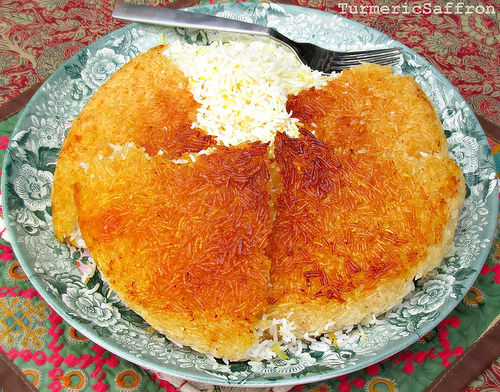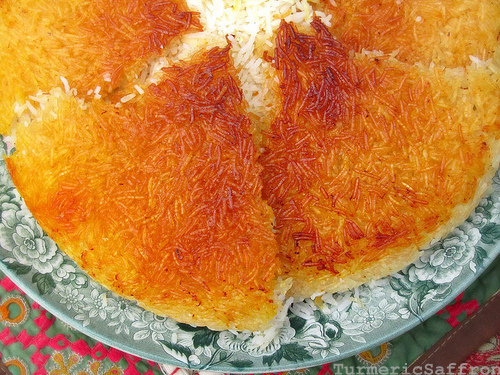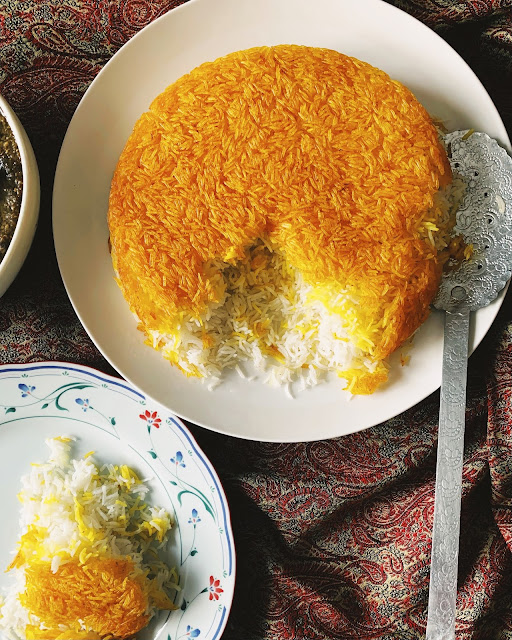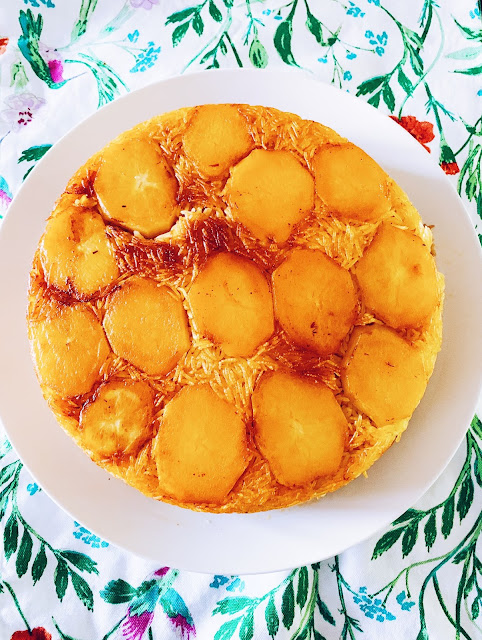This unplanned post was brought about due to a reader's question regarding tahdig. She asks: "Is there something I can do to get a better crust?" Great question! I've been blogging about Iranian food for months now but it didn't occur to me to write about tahdig, the tastiest and most sought-after part of a rice dish. If only tahdig could speak it would probably be saying "I get no respect!." I feel I've neglected a precious and very important part of Persian cuisine.
I write it as 'tahdig.' You may write 'tahdig'/'tahdeeg', however, it's pronounced tadeeg. "Tah" means bottom and "dig" means pot in Persian/Farsi language. ته دیگ Tahdig refers to the crunchy and crispy bottom layer of rice cooked in a pot. The formation of tahdig is a perfect symphony between the right temperature, the amount of oil, aromatic rice, length of time, right kind of pan, some experience, and a little patience. If you don't achieve the best kind of tahdig the first time, don't worry. There's always the next rice dish you can experiment with. Since rice is a staple of Iranian cooking that's how we have eventually been able to conquer the art of making tahdig. As the old adage goes: "practice makes perfect!" And if this is any consolation, let me tell you that even experienced cooks falter sometimes.
I write it as 'tahdig.' You may write 'tahdig'/'tahdeeg', however, it's pronounced tadeeg. "Tah" means bottom and "dig" means pot in Persian/Farsi language. ته دیگ Tahdig refers to the crunchy and crispy bottom layer of rice cooked in a pot. The formation of tahdig is a perfect symphony between the right temperature, the amount of oil, aromatic rice, length of time, right kind of pan, some experience, and a little patience. If you don't achieve the best kind of tahdig the first time, don't worry. There's always the next rice dish you can experiment with. Since rice is a staple of Iranian cooking that's how we have eventually been able to conquer the art of making tahdig. As the old adage goes: "practice makes perfect!" And if this is any consolation, let me tell you that even experienced cooks falter sometimes.
Lavash Tahdig
Potato tahdig
There are many kinds of tahdig. The most well-known is rice tahdig. There's also potato tahdig (my favorite) which goes well with rice and chicken dishes. If you choose to layer the bottom of the pan with potato slices, cut them evenly and not too thin. Add a dash of salt after layering them, wait for a few minutes till they are a little bit fried, then turn them over, pour the rice over the potatoes, and follow the same steps as the rice tahdig recipe. There's also the bread tahdig. Any kind of flatbread could be used such as lavash or pita. I've had lettuce ta-dig too. It's very delicious. Then there's the very tasty macaroni tahdig. A fantastic combination of crispy noodles, fresh tomatoes, and flavorful meat sauce.
Rice and Tahdig
Ingredients:
Serves 4-6
2 cups long-grain white basmati rice
Butter or vegetable oil
1/2 teaspoon powdered saffron dissolved in 4 tablespoons of hot water
Salt
Water
Method:
Ingredients:
Serves 4-6
2 cups long-grain white basmati rice
Butter or vegetable oil
1/2 teaspoon powdered saffron dissolved in 4 tablespoons of hot water
Salt
Water
Method:
- In a large bowl wash the rice with cool water a few times to get rid of the extra starch. Soak the rice in 6 cups of cool water, add 3-4 tablespoons of salt, set aside for an hour.
- In a large non-stick pot that has a tight-fitting lid, bring 6 cups of water to a rapid boil on medium-high heat.
- Drain the rice and pour it into the boiling water. Bring the water back to a boil on medium-high heat for about 7 minutes or until the grains are long soft on the outside and hard in the center. Drain the rice in a fine-mesh strainer and rinse with cool water.
- Place the pot on the stove over medium heat. Add 3 tablespoons of vegetable oil and 2 tablespoons of liquid saffron to the bottom of the pot, move the pan in a circular motion or use a wooden spoon to evenly cover the bottom with oil.
- Transfer parboiled rice back into the pot, building it into a pyramid shape away from the sides of the pot.
- To release the steam make 4-5 holes in the rice with the handle of the wooden spatula.
- Wait for about 5-7 minutes or until steam starts coming out.
- You can add a few cubes of butter on top or pour 2 tablespoons of oil and 1/4 cup water, cover, and cook over medium-low heat for 45-50 minutes.
- It is very customary to cover the lid with a kitchen towel or 2-3 layers of thick paper towels to prevent the moisture from going back in the pot. Nowadays, there are fabric lid coverings especially made for this purpose in Iran. I do recommend using it for making a perfect tahdig.
Enjoy!








Oh my goodness Azita, this is my favorite ever. My brother in law parent is Iranian. He thought me how to make this rice. It's become my favorite.
ReplyDeleteLove Tahdig! Yum! It is on my list of posts too!!
ReplyDeleteElra, Thanks!
ReplyDeleteMy Persian Kitchen, Yes, I saw your beautiful bread tah dig!
Azita: I love tah dig too! I have made it a bunch of times and I succeed 50% of the time in getting it out of the pan intact! ( I use yoghurt in the crust too)
ReplyDeleteoh wow this looks yummy what an interesting post love your blog have a great weekend Rebecca
ReplyDeleteand an Art is is. beautiful, Azita. and mashallah what an amazing large family you have. the more siblings, the merrier. we are three sisters. :) x
ReplyDeleteTaste of Beirut, It happens to me too!
ReplyDeleteChow and Chatter, Thank you Rebecca.you're very kind.
Shayma, We had a very loud and busy household with lots of friends/people coming and going all the time. I have two girls and enjoy a more peaceful home. Sometimes.:)
I'm glad I found your blog...it's wonderful!
ReplyDeleteI have seen this is a magazine and wanted to try it out. i wasn't sure I could do it. Thanks for the detailed recipe.
ReplyDeleteDeeba PAB, Thank you.
ReplyDeleteSoma, Give it a try. It's delicious!
Ive always loved Tahdig since I was young but I've never attempted it because I felt it would never turn out right.I will give it a try using your recipe.Thanks for sharing.
ReplyDeletecmiranda, give it a try, making tahdig is not as difficult as it may seem. let me know how it turns out! thanks for visiting.
ReplyDeleteHi Azita,
ReplyDeletelove your blog! keep 'em coming! quick question- do you boil/cook the rice before starting to build the bottom with the pyramid of rice? if not, then would 1 cup of water for 2 cups of rice be enough?
Pomegranad-lady, yes you need to parboil the rice before making it into a pyramid. Here's the link to how to make rice:http://turmericsaffron.blogspot.com/2008/12/rice-polow.html
ReplyDeletelet me know how it turns out. thanks for stopping by.
Hi. I'm new to Persian cooking. My fiance is Iranian and I just got the cookbook "A Taste of Persia." I've only attempted the rice so far. :) Anywho, I made it in my rice cooker and the bottom of the cake did form a crust but it was just sticky and very slightly browned. There was no crunchy tahdig going on. The shape, and saffron in the middle was beautiful, but I was bummed about the poor tahdig. My cooker only has a white rice option and a brown rice option. I used the white option for white basmati.
ReplyDeleteWhat went wrong?
Elizabeth, That's a good start! I suggest using a non-stick rice cooker and cook the rice for an additional 15 minutes or so. There are Iranian non-stick rice cookers that are good for making tah dig, you may find them in Iranian stores. Let me know how it turns out. Good luck!
ReplyDeleteOh my gosh, I LOVE tah dig! I've never made potato tah dig; I've just used a tortilla (my favorite!) or the rice itself (also very good.) And my Iranian friend told me that lettuce is sometimes used, but I've never tried it. Unfortunately, I can't eat rice anymore since I'm on a special diet, so I'm glad I can enjoy tah dig vicariously through your beautiful pics. :)
ReplyDeleteAzita - I looove tahdig, but I've always been afraid to make it myself. Your method says to use a heavy non-stick pot, but are there any specific brands or anything that you recommend using?
ReplyDeleteRose, I use good quality non stick cookware mainly for rice because the bottom crust (tah-dig) is prone to sticking and burning. So far, I'm satisfied with Cuisinart(GG Eco-Friendly) products. Give it a try and let me know how it turns out!
ReplyDeleteBest wishes,
Azita
Hi Azita, my potatoes in the tadig don't come out crunchy but always soft. I usually fry the potatoes in oil on both sides on high flame till golden, then lower the flame to the lowest, add the rice and cover with a towel and lid and let cook for another hour or so or till I see steam coming out ... what am I doing wrong?
ReplyDeleteThanks!
Mika, I would lightly fry one side of the potatoes in hot oil with a dash of salt on medium-high heat, turn them over and then I add the rice. You'll need to wait a few minutes until the steam starts coming up from the rice in the pot, wait for couple of minutes then you'll lower the heat, wrap the lid with a towel cover and cook for about an hour.
ReplyDeleteThanks! Will try!! I hope my potatoes will be crunchy this time!!! :) thanks!
ReplyDeleteI usually use my rice cooker, so I bring rice, salt and water to a boil, let boil for about 2 minutes, then pour into a strainer. In the pot, I put a tablespoon ghee, cover the bottom with either thin slices of raw potatoe or thinly sliced Persian bread, then heap the rice into the pot and form a pyramid (like you describe above). I then put the cooker to "dark crust" (makes about 30 to 40 minutes). That's all. The rice turns out perfect, the tahdig deliciously crisp. I usually turn it all over onto a serving plate, just like a cake.
ReplyDeleteWhen using a heavy pot instead of the cooker, I make sure I put the heat to minimum, not more. The rice (pre-cooked, like above) then takes about 30 minutes to be ready.
Oh, and tahdig with yoghurt and an egg yolk is also very tasty.
Cabbage is also nice for a different type of tah-dig.
ReplyDeleteall the recipes i've seen or tahdiq look so incredibly unhealthy, especially because they use at least a cup of oil! good to see that there's less oily possibilities, so i'll give it a go next time. looking forward to the potato tahdiq the most.
ReplyDeleteone question though: why should the rice be stacked up in a pyramid shape? a lot of persian cooking blogs emphasize that but i haven't found any difference in doing this or just cooking a flatter pot of rice. do you know? :)
Stacking up the rice in a pyramid shape keeps the rice more fluffy and easier to release the steam by gently poking a few holes in the rice. Also, keeping the rice in the middle prevents the rice from sticking to the sides and getting dried/burnt. We only want the tahdig at the bottom for this kind of rice. It's okay to have a flat surface when making kateh or cooking rice in a rice cooker.
Deletehi azita! i love your blog. my boyfriend is persian and i love trying to make persian food for him. i'm making him tachin tomorrow night (love your recipe) and i have a question. could i make tahdig on my tachin? if so, would i still have to use a pyramid shape? how long would i cook it on the stove for? any other tips? THANK YOU SO MUCH. your blog is so beautiful & amazing!
ReplyDeleteThank you, Buelsy. For tahchin you don't need to make the pyramid shape. Cook the the rice for about an hour in the oven or on the stove and it should have a thick layer of tahdig.
DeleteThanks for the detailed instructions. Just one question - when you say add a tablespoon of saffron to the butter/oil in the pan, do you mean a spoon of the saffron mixed with water? What happens to the rest of the saffron water (I guess it goes on top at the end of the cooking time?)
ReplyDeleteYes, that is what I meant to say. I made the necessary corrections in the recipe. Thank you.
DeleteThanks so much for your swift response, Azita! I'm going to try making this - I love tah-dig.
ReplyDeleteyears ago I had a persian boyfriend who taught me this. we used do dip the hot pan in cold water for a few seconds to release the crusty base before turning it out onto a plate. It works about 50% of the time!
ReplyDeleteWe also did a rice dish with vermicelli and sultanas that was delicious.
Have you tried making it with Lettuce ?
ReplyDeleteNot yet! I'm going to give it a try soon!
Deleteyou have the best collection of recipes and the best tasing. well done Azita jan
ReplyDeleteHi Azita!
ReplyDeleteMy sister once made a DELICIOUS tahdig, it was thick and crispy.
She said her secret ingredient that made it so wonderful was yogurt...I've tried looking for other tahdig recipes that suggest this, but haven't been successful, do you have any input on this?
Hi Nasrin jan, you can mix a cup of rice, 2-3 tablespoons plain yogurt, saffron and oil/butter, cover the bottom of the pan with the mixture and continue following the recipe as directed.
DeleteThank you for this. I am so glad I came across your blog! I have a very eclectic way of cooking, thanks to my military father and our travels and a dear friend of mine as a child was Iranian. I remember eating family dinners at her home and I remember watching her mother and grandmother cook and I try so hard to remember things. Now I am grown with a family of my own and when I cook my mom tells me I must be Persian. I take it as a compliment. I can't wait to try out some of the recipes you have!
ReplyDeleteHi! Was Just reading about your Tah Dig! I was taught that if one runs cold water over the outside bottom of the pot of rice just before serving, that the tah dig is much easier to remove. We also would put the towel on the lid after the steam had started rising...2 or 3 minutes of the beginning heat with only the bare lid. I
ReplyDeleteLove your Blog...and what a nice name!
Hi, 1 question, for the potato tahdig... do I par boil the rice first, then add potato to the bottom of the pan and continue from there? or are the potato's there from the start, (and if so, what is the best way to then drain the rice>
ReplyDeleteHi, you parboil the rice first, drain rice using a colander, add oil to the bottom of the pot, layer the sliced potatoes, add the rice, cover and cook.
DeleteAzita Jan, this is brilliant! I tried Tahdeeg yesterday from an Iranian restaurant, and it was amazing! So thick, and crispy and saffron-y! Do you have any special tips to prevent the Tahdeeg from burning? And will ghee be okay instead of butter?
ReplyDeleteAmay, use enough vegetable oil or ghee to cover the bottom of the pot over medium heat. Add the rice, reduce the heat when steam starts coming up and cover the lid with a clean kitchen towel and cook the rice on low heat. Thank you!
DeleteHi, have you ever made potato tahdig in the Persian rice cooker? If yes can you please share your expertise?
ReplyDeleteHi, I have not tried the potato tahdig in the rice cooker and I don’t think it will come out as crispy as I would like it to be. If you happen to try it please let me know how it turns out.
DeleteThe recipe I was taught added apricot and golden raisins with cardamom.
ReplyDeleteI am trying to perfect the plain crust before moving on to yoghurt and I am trying to make my crust the nice, golden-orange you have there. I think it's in the "frying" stage that this occurs. Can you explain why you need to wait for steam to come out? Does that mean all of the water has gone? I managed to get a uniform crust with a few grains here and there blackened a little, but the golden-orange eludes me.
ReplyDeleteYou need to allow excess water to steam off for a few minutes and then cover the pot with a lid. Add a little bit more saffron water.
DeleteI have been trying to find out if you can make tah-dig using an electric pressure cooker.
ReplyDeleteHas anyone tried this and if so please post instructions. I have the Power Pressure XL
Thanks
Jennifer, I've never used a pressure cooker to make rice.
DeleteJen,
DeleteDid you ever figure out how to use your pressure cooker to make tahdig?
I only have saffron threads, how can I substitute the powder for threads?
ReplyDeleteJenn, you can crush the saffron threads with a mortar and pestle to a fine powder.
Deleteazita i love you !
ReplyDeleteI can't wait to try it! To clarify, the instructions in step #8 indicate to pour "1/4 cup and saffron over the rice." Is that 1/4 cup of water? Or ...? Thank you so much for the recipe!
ReplyDeleteI just made a correction to the recipe. Thank you.
DeleteAzita, I made the Tahdig recipe and it came out AWESOME. Worth the wait. Although it took a long time for rice to cook, it gave me ample time to make the Pork and Lamb Koobideh which was also fantastic.
ReplyDeleteDear Azita, Thank you for your beautiful posts and delicious recipes. I'm wondering if you could put up a recipe for macaroni tahdig. I remember my mom making ماکارونی؛" very much like the American spaghetti dish with meat and tomato sauce and somehow she was able to render a nice tahdig under it all. I've tried to make it but the pasta sticks to the bottom of the pot and doesn't form a sheet of tahdig regardless of how much oil I use. I would appreciate any thoughts or tips you may have. Thank you much.
ReplyDeleteYou might want to use a high quality non-stick pan. Here's a link to my macaroni recipe:https://turmericsaffron.blogspot.com/2010/07/upside-down-persian-macaroni-with.html
DeleteThank you for forwarding your macaroni recipe. It looks beautiful and delicious.
ReplyDeleteI use cast iron (enamel coated inside) Le Creuset pots and pans. Would you recommend non-enamel?
Behess, I use both uncoated cast iron and enameled cast iron pots and pans. A cookware with a non-stick coating works great for rice and macaroni tahdig.
DeleteHi Azita.
ReplyDeleteI tried this rice in a Persian party... I just loved it and I'm trying to do it but I just have a question. When should I put the bread? I know it should be on the bottom but I will like to know how to do it please.
Thank you in advance
Hi Mirnuccia, add oil to the bottom of the pan, place a layer of flat bread/lavash, spread the rice over the bread and follow remaining directions.
Deleteadd a sprinkle of salt to the butter, vegetable oil and saffron too! DELICIOUS
ReplyDelete